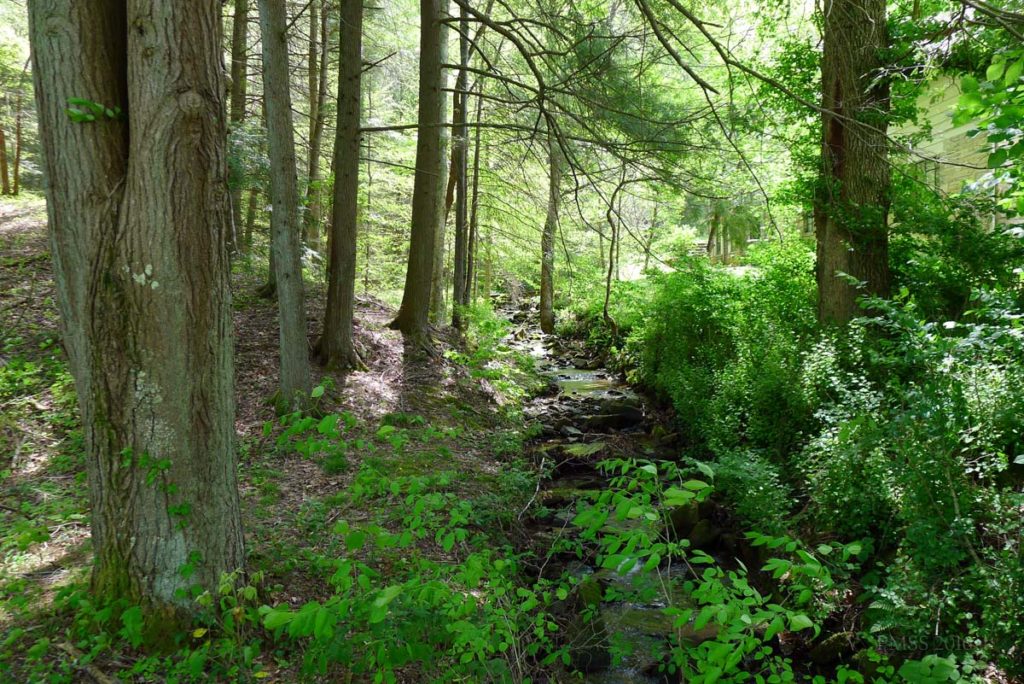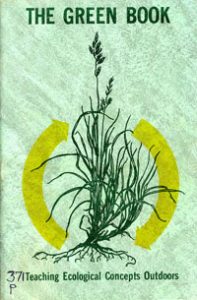Pine Mountain Settlement School
Series 22: ENVIRONMENTAL EDUCATION
Overview, EE Mission, Goals, Philosophy of EE
EE Endorsement by PMSS Board, 1978

Forest and Limestone Creek at PMSS. (Photo: hhw) [P1130799.jpg]
TAGS: environmental education, EE, Pine Mountain Settlement School, Harlan County, Kentucky, education, Mary Rogers, Peter Westover, Nat Kuykendall, civic responsibility, weaving, hiking, stream ecology, curriculum, standard course of study, public schools, sustainable agriculture
ENVIRONMENTAL EDUCATION (EE)
The Development of the Environmental Education Program at PMSS
Environmental Education (EE) programming at Pine Mountain essentially began with the founding of the School. While not defined in the early curriculum of the School, environmental education was introduced at every opportunity beginning in its earliest years. The discovery of the Native American dwelling and burial site at Indian Cliff, the discussion of the ancestral heritage of students from the region, landscaping and farming as part of the vocational training experience of students, and other related environmental experiences, continue to be constant reminders to staff and students of the beautiful and fragile shared environment of the School. Pine Mountain has always defined environmentalism as one of its educational missions. The consistency in the efforts to raise awareness of the surrounding natural environment is a persistent theme that runs through the institution’s history. Educational programs at the School have always centered on the surrounding environment and the need to honor its diversity and its wealth of academic lessons. The environmental awareness of all who have worked and/or attended Pine Mountain Settlement School’s programs is a lesson for life.
Perhaps no one was as fully committed to the idea of complete immersion in the natural environment of the School as was Mary Rogers, the wife of former Director, Burton Rogers. It was through the efforts of Mary that the School’s transition to the formal educational programming of environmental education was born. The idea that environmental education was fundamental to civic responsibility began with the founders, but it was strengthened by various staff who foregrounded environmental education in multiple offerings of hands-on adventures following the closure of the boarding school. While attention to the environment had always been a part of the ethos of the School from its beginning, the closure of the Boarding School opened a new chapter in the relationship of the School to its surrounding environment.
The Formal Institution of the Program
While the fundamental ideas surrounding environmental education have always been part of the School, the foundation of a formal Environmental Education Program, conceived and promoted as part of the School’s mission, did not occur until the 1970s. From that era forward, the School began to cast a wide net for incorporating environmental awareness into the educational planning of regional schools and it became a leader in the growing environmental education movement. Today that programming sits at the center of most of the institution’s programming.
In the beginning, the Pine Mountain programs sought to educate for natural resource stewards of the future in the young students who participated in the institution’s programs. Soon, supplemental programs also reached out to adults with a series of workshops and retreats that focused on the rich ecology of the School and its surrounding classroom. Today, the ideas put forward by the School’s EE staff are designed to bring children and adults to Pine Mountain, where they can experience an introduction to good environmental stewardship through actual hands-on exercises. Whether walking a trail or engaging in natural science workshops, expeditions, an afternoon of hands-on stream ecology, or a classroom talk on Native Americans, or the area’s rich salamander population, the environmental education staff opened the way for schools to incorporate the Kentucky standard course of study with extended hands-on experiences. The institution’s strong programming was a model that schools throughout Kentucky soon emulated and began to add to incorporate into their field excursions or week-long on-site programming.
With the passage of time and the multiple intervening administrations, environmental education at the School has evolved and changed and waxed and waned. Yet, it has rarely strayed too far from its original educational conception developed by Mary Rogers, Afton Garrison, Peter Westover, Larry Smith, and many other early environmental education designers and instructors.
Following the formal institution of an Environmental Education program in 1972 at Pine Mountain Settlement School, the EE programs soon reached out to over 3,000 children and adults each year through a series of on-site and short-term residential programs for schools and in adult workshops that focused on a planned environmental education program.
ENVIRONMENTAL EDUCATION: Goals and Philosophy, Board Endorsement
In 1978, a formal endorsement by the Trustees of the School was made for a program of Environmental Education at the School.
1978 BOARD ENDORSEMENT – ENVIRONMENTAL EDUCATION (EE)
AS A FUNDAMENTAL PROGRAM
The Trustees of the Pine Mountain Settlement School, realizing the alienation that exists between many modern-day people and their natural environment, believe that the abundant natural resources of the Pine Mountain Settlement School should be put to use in a program of environmental education.
The goals and philosophy of the environmental education program are:
-
- to help visitors come “to see and respect the visible creation which mirrors the glory and the perfection of the invisible God. (Thomas Merton)
- to offer mountain students, young and old, the opportunity to learn from the earth and to understand and appreciate better the rich heritage of our region, and their role of responsible stewardship for its future.
- to give students from other regions an interpretation of our culture and natural environment through first-hand experiences. These experiences, which give a deeper understanding of a person’s own attitudes, also provide a frame of reference with which to compare other environments.
- to present environmental education not as a single subject, but as an integral part of all subjects. We hope to help participants learn by involvement and discovery, rather than merely hearing and reading.
April 22, 1978
ENVIRONMENTAL EDUCATION: The Green Book

“Green Book,” Cover. [ee_green_book_cover_2.jpg]
The Green Book, Teaching Ecological Concepts Outdoors (1974), was the earliest roadmap of the Environmental Education program. It provided lesson plans and a rationale for many of the activities associated with the specific modules of the environmental education program. This guiding document has been rewritten numerous times and is still evolving as it keeps pace with the changes in the Standard Course of Study required in the public schools and with the changes in administration at those Schools, and at Pine Mountain Settlement. Today, the growing need for programs that educate across a range of ages and that raise the growing contemporary issues related to the environment could not be greater, and the range of concepts brought to the School by its young and older staff has enriched the institution’s offerings.
The programs have also expanded their base to include craft and creativity, with hands-on sessions in the weaving room, ceramics studio, woodwork shop, and other art and craft engagements. The expansion of workshops for adults took some of the early environmental education programs and expanded them into multiple hands-on experiences with the environment, as well as with specific regional interests such as heritage seeds, medicinal plants, sustainable agriculture, weaving, blacksmithing, architectural restoration, canning, photography, and a myriad of other interests geared for both adults and children.
The Green Book continues to provide one of the best descriptions of the ongoing EE concepts and the practice of environmental education at Pine Mountain:
Environmental education has come to mean many different things. Sometimes, unfortunately, it has involved a separation of two kinds of learning: the learning of awareness and appreciation through the use of the senses; the learning of knowledge — specific truths — through experimentation.
We hope through this guide to help bring the two areas together and to stimulate the learning of additional skills such as that of effective communication. Through ecological concepts, one realizes that “awareness” is necessary not only for aesthetic appreciation but also for the understanding of concrete situations.
In THE GREEN BOOK, we emphasize the importance of using concepts or frameworks to understand the ways that plants, animals, water, soil, air, and people fit together. Each natural system — “ecosystem,” may be different, but most have underlying similarities. Unless we have a frame of reference for seeing those similarities, and unless we can see, describe, and differentiate among members of each ecosystem (which plants, what kind of rock material, how big an animal population), we cannot understand how each affects the others.
The Green Book, 1972.
The physical campus of Pine Mountain Settlement is a natural environment. As a backdrop for an environmental education program, the campus could not be more exquisite or diverse. See Pine Mountain Settlement School Events for a listing of current programming and consult the archive as we add material from the previous years.
See:
ENVIRONMENTAL EDUCATION Guide
See Also:
ENVIRONMENTAL EDUCATION Staff 1972 to Present
GOVERNANCE 1977-1978 Philosophy of Pine Mountain Settlement School

